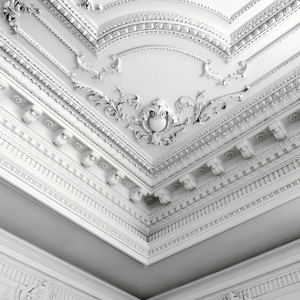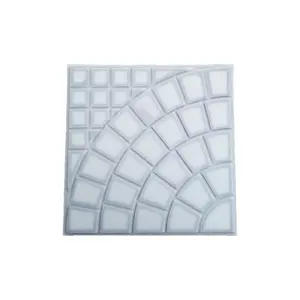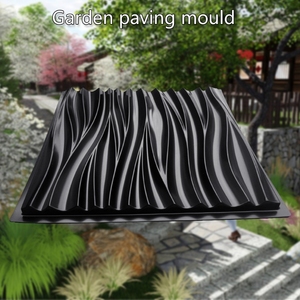(191008 products available)













































































































































































Decor moulds are used by designers to replicate decorative details on furniture, objects, and architectural elements. They come in different types, each serving a unique purpose. Here are some of them:
Silicone moulds
Silicone moulds for decor are flexible and can be bent to release casted items easily. They come in different types, including tin-cure, one-part, and self-sustaining moulds. These moulds are popular because they produce detailed and accurate castings. They are also durable and resistant to tearing. Silicone moulds can be used to cast different materials, including resin and gypsum.
Plaster moulds
Moulds made of plaster are cheaper and easy to make. However, they produce less detailed castings. The castings are also prone to breakage. Plaster moulds are mainly used for single casting.
Thermal plastic moulds
These types of moulds are made from thermoplastics. They are popular for their outstanding durability. The moulds can be reused multiple times without losing their original shape. However, releasing the cast can be difficult.
Wooden moulds
These are traditional moulds used in the past. They are not popular in the modern world because they are not versatile. They also produce less detailed castings.
Ornamental moulds
These moulds are used to create decorative and intricate details on many items. They come in different designs, including floral, geometric, and vintage patterns. Users can create various ornamental pieces, such as crown moulding, picture frames, and furniture accents.
Furniture repair moulds
These moulds are specifically designed to cast missing or damaged components on furniture. They help restore furniture to its original look and value. Repair moulds can replicate intricate details found on antique and ornate furniture.
Cabinetry moulds
These moulds create decorative accents for drawers and cabinet doors. They add customisation and elegance to cabinetry. Moulds can create raised panels, intricate borders, and decorative knobs.
Baseboard and crown moulding silicone moulds
These moulds create crown moulding and baseboards used in interior design. They create quick and customised moulding options. Baseboard and crown moulding silicone moulds add finishing touches to any room.
Decorative mouldings and trim are used throughout the home to add architectural detail and visual interest. Below are some features of decor moulds that can be offered to buyers:
Versatile Design
Decorative moulding is designed to be versatile so that it can be used in various applications. This includes crown moulding, chair rails, baseboards, and accent wall panels. It can also be used to create custom features like coffered ceilings and wainscoting.
Easy Installation
Many types of decorative moulding are designed for easy installation. This includes pre-finished moulding that does not require painting or staining. Some moulding can also be installed using adhesive instead of nails or screws.
Low Maintenance
Decorative moulding is designed to be low maintenance. Once it is installed, it does not require painting or staining. Moulding is also easy to clean; it only needs to be wiped with a damp cloth to remove dirt and dust.
Materials
Decorative moulding is available in different materials, each offering unique features and benefits. For instance, wood moulding provides a classic look, while MDF (medium-density fibreboard) moulding is cost-effective and easy to work with. PVC (polyvinyl chloride) moulding is durable and water-resistant, and polyurethane moulding is lightweight and easy to install.
Customizable
Decor moulds are customizable to meet the specific needs and preferences of buyers. This includes moulding in different shapes, sizes, and profiles. Buyers can also choose from a wide range of finishes, including paint, stain, and natural wood.
Enhances Property Value
Decorative moulding adds architectural detail and visual interest to a home, enhancing its appeal and value. It can also be used to create custom features that set a home apart from others.
Decor moulds are used in various industries, and each industry decorates different products. Here are some of the industries that use decor moulds:
When choosing the decor moulds to wholesale, it is important to consider different factors to ensure customers' needs are met. This includes;
Material
Decor moulds are made of different materials, and each has its advantages and disadvantages. Some of the common materials are:
Silicon - silicone moulds are popular because they are flexible, non-stick and can be used in high and low temperatures. They are great for making intricate designs. Silicone moulds are, however, more expensive than other materials.
Plastic - plastic is a popular material used to make decor moulds. Plastic moulds are durable and come in different shapes and sizes. They are also cheaper than silicone moulds but less flexible and prone to sticking.
Metal - metal is a strong and durable material used to make decor moulds. Metal moulds provide even heat distribution, resulting in consistent output. They are, however, heavy and not very flexible.
Paper - some decor moulds are made from heavy-duty paper. These moulds are lightweight and easy to store. They are also good for one-time use or small projects.
Consider the type of material used to make the moulds, as it will affect the performance and price.
Design
The design of the moulds will determine the type of decor items produced. It is important to consider the different designs available in order to meet the customers' needs. Look for moulds that have intricate designs, textures and patterns to create unique decor items.
Ease of use
Wholesale decor moulds that are easy to use. Consider moulds that are non-stick, flexible and easy to clean. This will help reduce the time spent in the production process.
Size
Customers will buy decor moulds in different sizes depending on the size of the decor items they want to produce. It is important to have a variety of sizes in stock to cater to different customers' needs.
Price
Customers will always look for decor moulds that are within their budget. It is important to consider the price of the decor moulds to ensure there is a profit margin. Compare prices from different suppliers and consider the quality of the moulds.
Q1: What is the difference between moulding and mould?
A1: Mould refers to a hollow frame used to give shape to liquid metal during casting. Moulding, on the other hand, is the process of shaping liquid metal in a mould.
Q2: What are decorative silicone moulds?
A2: Decorative silicone moulds are shaping tools made of silicone used for casting and creating decorative items. They are popular in the decorative industry because silicone is non-stick and can withstand high temperatures.
Q3: Are decor moulds reusable?
A3: Most types of decor moulds are reusable. However, to ensure they remain in good condition, users should clean and store them properly.
Q4: Can decor moulds be used for different materials?
A4: Some decor moulds can be used for different materials, such as silicone moulds that can be used for resin, plaster, and concrete. However, it is important to check the manufacturer's guidelines to ensure the mould is compatible with the material.
Q5: How do users maintain and store their decor moulds?
A5: Users should clean the moulds with lukewarm water and a soft cloth to remove any debris. They should avoid using abrasive cleaners that can damage the mould. Users should air dry the moulds and store them in a cool, dry place away from direct sunlight.